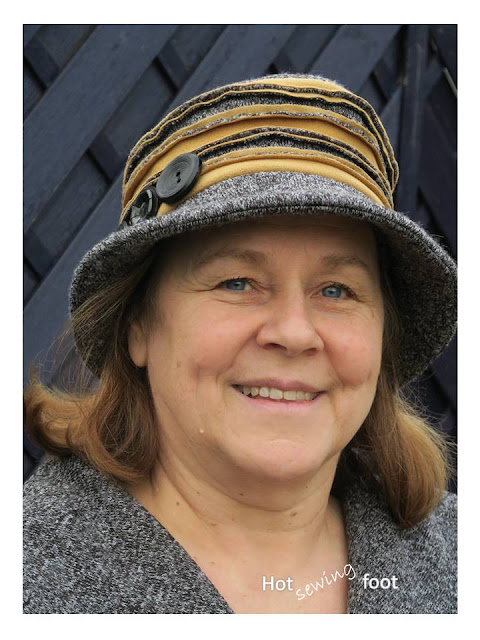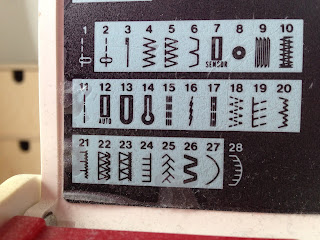My first pair of tailored trousers (Sara pleated pants by Fabric-Store.com
This is my entry for the pants sewing contest on Sewing Pattern Review. The entrants were meant to stretch their skills.
I was stumped at first. I prefer to wear and sew pull-on pants because they are comfortable and I always wear a long top over them anyway. But these wouldn't be enough.
I could sew a pair of real jeans for my youngest daughter. She reminded me, that we had bought some cotton fabric for her at IKEA
that was meant for pants. So why not sew a pair of tailored trousers?
Never done that before, but where there's a will, there's a way.
The main problem with this, however was, that there were only 2 weeks left to finish the garment. On top of that, my youngest would be
going on a trip in 5 days and would not be back before the contest
ended. The muslin had to fit by then and there wouldn't be modeled
photos of the finished garment. Oh well, let's give it a try.
Pattern:
I chose the Sara pants because they are cut high waisted, not super
tight and slightly tapered in the leg. In addition, they have slant
pockets and small pleats in the front, back darts for shaping, a zipper
front fly and belt loops.
I had downloaded the pattern a few months ago. The pattern is free if you register here.
Pattern Sizing: 0/2 to 28/30. According to the measurements my
daughter needs a size 10/12 for the waist and a size 14/16 for the hips.
I have printed a size 12/14.
Fabric Used: Coton curtain (medium weight) from IKEA in a
houndtooth design, linen as contrast fabric.The choice of fabric has a
great impact on the look of the pants.
Instructions:
The instructions are very clear and there is even a tutorial for the zipper fly and for the belt loops
Pattern alterations or any design changes you made:
Since my daughter is one size smaller in the waist than the hips, I
sewed the hips with only 1/4" seam allowance and the waist with 5/8". I
was quite surprised that the muslin fit quite well. It didn't dip in the
back and didn't gape too much at the waist, issues my daughter often
has in RTW pants.
Increased the back crotch width by 1 inch (due to wrinkles radiating to the back crotch)
Overlapped a wedge going from zero at the side seam to 1/2" at the inner back thigh (due to excess fabric under her butt).
Tapered the outer leg seam going from zero at the low hip to 3/8" at the knee and down to the ankle.
Replaced the front pleats with darts because they weren't flattering.
Added single welt pockets at the back using the tutorial of David Page
Coffin: "Pant Construction Techniques" on Craftsy. The pocket is made of
cotton poplin which runs up to the waistband and the visible part of
the welt opening is layered with the outer fabric.
Replaced the single back darts with two darts because they distorted the welt pockets.
Cut the pieces in a single layer because I opted for horizontal pattern
matching and the grainline running exactly along the crease. Especially
the welt pockets had to be absolutely symmetrical.
Chose contrast fabric for the welts and the edging of the slant pockets.
If I had used the outer fabric for inside pockets, the pockets would
have been visible. Therefore, I used a light cotton fabric in beige for
the back pockets. For the side pockets I used the contrast fabric as the
top layer and for the cut on piping. (see photo).
Added a lining that extends to the knees, for comfort and because the
fabric was slightly see through. I chose a lining I had on hand, which
has a light blue and a light pink side. The pink side towards the upper
fabric is invisible from the outside. The fabric isn't as dark as it
appears on the photo.
French seams on the pockets and the lining.
Slipstiching the lining along the zipper fly and the inner waistband seam.
Doing a slip stitch on the hem.
What did you particularly like or dislike about the pattern?
Would you sew it again? Would you recommend it to others? A good fitting trousers pattern is hard to find. I would definitely recommend it for similar body shapes.
Conclusion:
I consider myself a intermediate sewist, because there are so many types
of garments and techniques that I have never sewn before. I didn't know
if I could really handle this task. I studied different methods to sew
welts. The method of David Page Coffin seemed the most "tailored" one,
but I had to watch it many times. Unfortunately he doesn't tell how he
prevents the fraying of the fabric. It was really not easy and relaxed
sewing. But my credo is: "You can accomplish anything. Just go slowly
and step by step. And even if you don't make it, you will learn a lot."
I really did learn a lot:
- Sewing my first welt pocket
- Sewing my first zipper fly
- Sewing my first belt loops
- Sewing a lining into pants (unfortunately after sewing the lining I
noticed that the pink side was the "clean" side and now the french seams
are visible on the inside of the pants.
Because I couldn't show the pants on a person I wasn't able to be judged at the contest. But I'd like you to see the modeled pants now.









Kommentare
Kommentar veröffentlichen